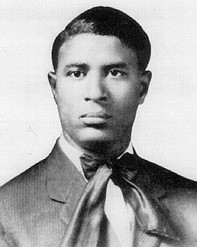Garrett Morgan
Garrett Morgan was born in 1877, in Paris, Kentucky. He was of Black, Native American, and white descent. Born to formerly enslaved parents, he was the seventh of eleven children. His mother’s name was Elizabeth Reed and his father’s name was Sydney who freed in 1863 and was the son of John Hunt Morgan, a confederate colonel.
As a youth he spent a lot of time working on his parent’s farm, eventually dropping out of school in the sixth grade. When Garrett was around 15 or 16 he moved to Cincinnati, Ohio so he could find a job. Eventually Garrett got a job at a sewing machine factory learning the ins and outs of the machine and how to fix them. As he got better with working on the machines he found a way to improve the machines and he got a patent to make an improved sewing machine. After the innovation was successful, he was able to open his own showing machine shop in 1907
As the business got stronger he eventually was able to establish himself and eventually married a woman named Mary Anne Hassek. Together Mary Anne and Garrett were able to open a tailoring shop since his wife was an experienced seamstress. While working with the sewing machines Garrett scorched the cloth that he was working with which was a common problem since the machine was sewing cloth with the needle at such high speeds. Garrett decided to experiment with a chemical solution in an effort to help reduce the friction between the needle and the cloth and as he was testing the substance he noticed that the hairs on the cloth were straighter. After noticing what it did he tested the cream on a neighboring dog and then he tested it on himself. When that worked, he quickly established the G.A. Morgan Hair Refining Company and he sold the cream to African Americans. The company became extremely successful and he found financial security which allowed him to pursue other interests of his own.
An innovation that Garrett made was a traffic signal with a caution signal, which has become today’s yellow light. Back then the traffic lights only had two lights, red and green. The traffic lights switched all of a sudden not giving any warning to the switch which caused many accidents. Garrett witnessed an accident between a car and horse drawn carriage. That’s when he got the idea to create a traffic light with a warning signal. The traffic signal was t-shaped. When the signal was in the shape of a “t” that meant stop, and when the two side signals were up at a 45 degree angle it meant caution. When the signals were up it meant go. After the new signal came out, many other countries picked up on the idea and used it on their roads.
One of his other inventions was the breathing device or “safety hood” allowing the wearers the ability to walk into places that were full of smoke, gases or other pollutants. The mask was initially made for firefighters but eventually became the prototype and the precursor for the gas masks used in World War I as the army walked through places that were filled with toxic gases. The invention earned him the first prize at the Second International Exposition of Safety and Sanitation in New York City. In the South there was some resistance among the buyers of his products because of racial tension. But Garrett thought of an idea where he acted as the assistant of the inventor and walked into all of the unsafe areas wearing the mask. This relaxed the resistance in the South which allowed more people to buy his products.
In Cleveland there was a drilling tunnel under Lake Erie looking for a fresh water supply. The workers hit a pocket of natural gas which resulted in a large explosion. The explosion trapped the workers with suffocating noxious fumes and dust. Garrett heard about the explosion and he and his brother went to help the men that were trapped in the tunnel. Using his gas masks they managed to save two lives and recover four bodies before the rescue effort was shut down. Unfortunately his sales were hurt because of the publicity of his efforts and the public was now aware that Garrett was an African American. He was actually Multiracial. After that many refused to purchase his products, and to add to the hurt, neither the inventor nor his brother were fully recognized for their efforts.
In 1943 Garrett started to develop glaucoma which is eye conditions that damage your optic nerve which is usually caused by high pressure in your eyes. Because of the damage in his eye he eventually lost most of his sight. Garrett died in Cleveland, Ohio on July 27, 1963, but just before his death he was restored to his place as a hero of the Lake Erie rescue.
William Thomas
Project Race Vice President

